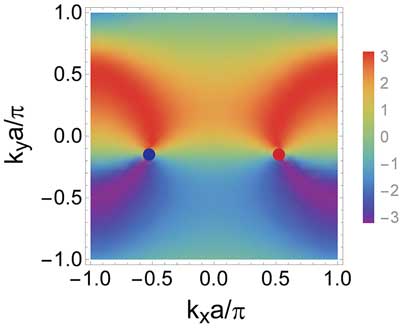| Posted: Mar 22, 2018 |
Small poke - huge unexpected response
(Nanowerk News) No earlier theory had envisioned that the responses would be so large! Scientists “poked” three crystals with pulses of light. Unexpectedly, the crystals exhibited the largest nonlinear optical response of any known crystal. The response was a huge amount of different colored light with twice the frequency of the pulse. These crystals are members of a new class of materials known as Weyl semimetals.
|
 |
| Elusive exotic states called Weyl fermions reside in certain semimetals. Semimetals conduct electricity like metals but have other properties that are like insulators. Weyl semimetals have electronic states that are strongly influenced by the underlying crystal symmetry. This particular subset of Weyl semimetals exhibits huge non-linear optical responses that result from the extreme bending (or curvature) of the electron states. The image depicts this curvature, with the strongest positive and negative responses colored red and violet, respectively. Features in the curvature are seen near special points known as the Weyl nodes. (Image: Lawrence Berkeley National Laboratory)
|
|
This work (Nature Physics, "Giant anisotropic nonlinear optical response in transition metal monopnictide Weyl semimetals") challenges our thinking on optical responses in Weyl semimetals.
|
|
The scientists expected light pulses to produce different colored light with twice the frequency but not such a huge response. The origin of this gigantic response is unknown!
|
|
This study is already stimulating the development of fundamentally new theories about these responses. These materials are promising for package-penetrating sensors, night vision goggles, and other devices.
|
|
Weyl fermions are novel particles that were predicted to be seen in high-energy physics experiments but have not been observed. However, scientists recently observed these particles as an emergent property of electrons in a unique set of semimetal materials.
|
|
Recent studies have shown that Weyl semimetals exhibit an unexpectedly large nonlinear optical response. This response gives rise to the largest optical second harmonic generation effect of any known crystal.
|
|
These observations were made in the transition metal systems: tantalum arsenide (TaAs), tantalum phosphide (TaP), and niobium arsenide (NbAs). Although it was clear from symmetry considerations that there would be a non-linear response in these systems, there was no theoretical prediction suggesting the large magnitude of response observed.
|
|
By comparison with other well-known nonlinear crystals, the non-linear optical response in these systems is larger by factors of 10 to 100.
|
|
Given the unexpected response, scientists anticipate these findings will stimulate the development of advanced ab initio methods to calculate nonlinear optical response functions in these materials.
|
|
Also, Weyl semimetals are expected to have a wide range of optoelectronic applications as materials to be used for the development of terahertz generators and far-infrared radiation detectors.
|

